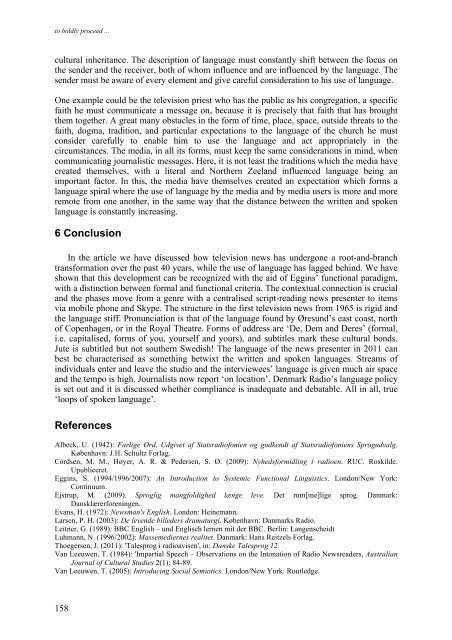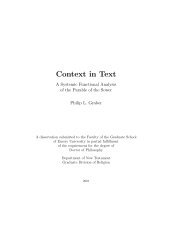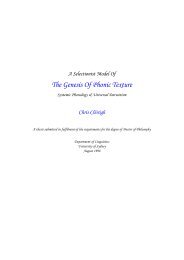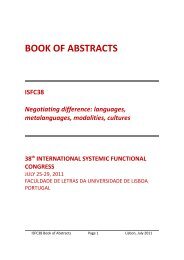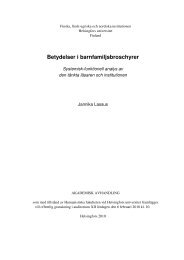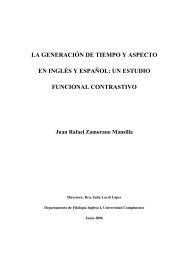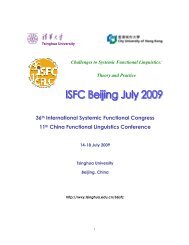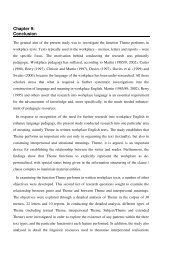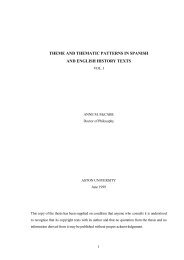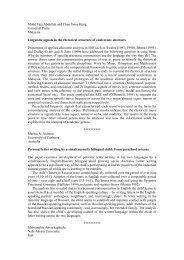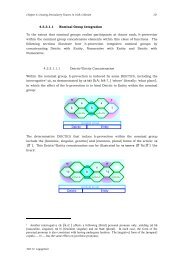the ISFC39 Proceedings - International Systemic-Functional ...
the ISFC39 Proceedings - International Systemic-Functional ...
the ISFC39 Proceedings - International Systemic-Functional ...
Create successful ePaper yourself
Turn your PDF publications into a flip-book with our unique Google optimized e-Paper software.
to boldly proceed ...cultural inheritance. The description of language must constantly shift between <strong>the</strong> focus on<strong>the</strong> sender and <strong>the</strong> receiver, both of whom influence and are influenced by <strong>the</strong> language. Thesender must be aware of every element and give careful consideration to his use of language.One example could be <strong>the</strong> television priest who has <strong>the</strong> public as his congregation, a specificfaith he must communicate a message on, because it is precisely that faith that has brought<strong>the</strong>m toge<strong>the</strong>r. A great many obstacles in <strong>the</strong> form of time, place, space, outside threats to <strong>the</strong>faith, dogma, tradition, and particular expectations to <strong>the</strong> language of <strong>the</strong> church he mustconsider carefully to enable him to use <strong>the</strong> language and act appropriately in <strong>the</strong>circumstances. The media, in all its forms, must keep <strong>the</strong> same considerations in mind, whencommunicating journalistic messages. Here, it is not least <strong>the</strong> traditions which <strong>the</strong> media havecreated <strong>the</strong>mselves, with a literal and Nor<strong>the</strong>rn Zeeland influenced language being animportant factor. In this, <strong>the</strong> media have <strong>the</strong>mselves created an expectation which forms alanguage spiral where <strong>the</strong> use of language by <strong>the</strong> media and by media users is more and moreremote from one ano<strong>the</strong>r, in <strong>the</strong> same way that <strong>the</strong> distance between <strong>the</strong> written and spokenlanguage is constantly increasing.6 ConclusionIn <strong>the</strong> article we have discussed how television news has undergone a root-and-branchtransformation over <strong>the</strong> past 40 years, while <strong>the</strong> use of language has lagged behind. We haveshown that this development can be recognized with <strong>the</strong> aid of Eggins’ functional paradigm,with a distinction between formal and functional criteria. The contextual connection is crucialand <strong>the</strong> phases move from a genre with a centralised script-reading news presenter to itemsvia mobile phone and Skype. The structure in <strong>the</strong> first television news from 1965 is rigid and<strong>the</strong> language stiff. Pronunciation is that of <strong>the</strong> language found by Øresund’s east coast, northof Copenhagen, or in <strong>the</strong> Royal Theatre. Forms of address are ‘De, Dem and Deres’ (formal,i.e. capitalised, forms of you, yourself and yours), and subtitles mark <strong>the</strong>se cultural bonds.Jute is subtitled but not sou<strong>the</strong>rn Swedish! The language of <strong>the</strong> news presenter in 2011 canbest be characterised as something betwixt <strong>the</strong> written and spoken languages. Streams ofindividuals enter and leave <strong>the</strong> studio and <strong>the</strong> interviewees’ language is given much air spaceand <strong>the</strong> tempo is high. Journalists now report ‘on location’. Denmark Radio’s language policyis set out and it is discussed whe<strong>the</strong>r compliance is inadequate and debatable. All in all, true‘loops of spoken language’.ReferencesAlbeck, U. (1942): Farlige Ord. Udgivet af Statsradiofonien og godkendt af Statsradiofoniens Sprogudvalg.København: J.H. Schultz Forlag.Cordsen, M. M., Høyer, A. R. & Pedersen, S. Ø. (2009): Nyhedsformidling i radioen. RUC. Roskilde.Upubliceret.Eggins, S. (1994/1996/2007): An Introduction to <strong>Systemic</strong> <strong>Functional</strong> Linguistics. London/New York:Continuum.Ejstrup, M. (2009). Sproglig mangfoldighed længe leve. Det rum[me]lige sprog. Danmark:Dansklærerforeningen..Evans, H. (1972): Newsman's English. London: Heinemann.Larsen, P. H. (2003): De levende billeders dramaturgi. København: Danmarks Radio.Leitner, G. (1989): BBC English – und Englisch lernen mit der BBC. Berlin: LangenscheidtLuhmann, N. (1996/2002): Massemediernes realitet. Danmark: Hans Reitzels Forlag.Thoegersen, J. (2011): 'Talesprog i radioavisen', in: Danske Talesprog 12.Van Leeuwen, T. (1984): 'Impartial Speech – Observations on <strong>the</strong> Intonation of Radio Newsreaders, AustralianJournal of Cultural Studies 2(1): 84-89.Van Leeuwen, T. (2005): Introducing Social Semiotics. London/New York: Routledge.158


